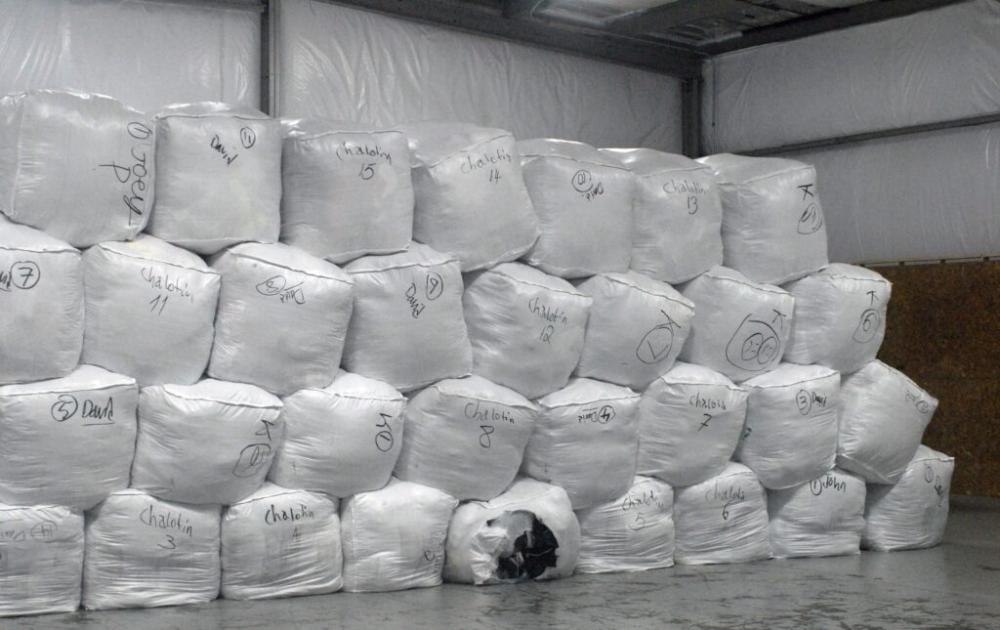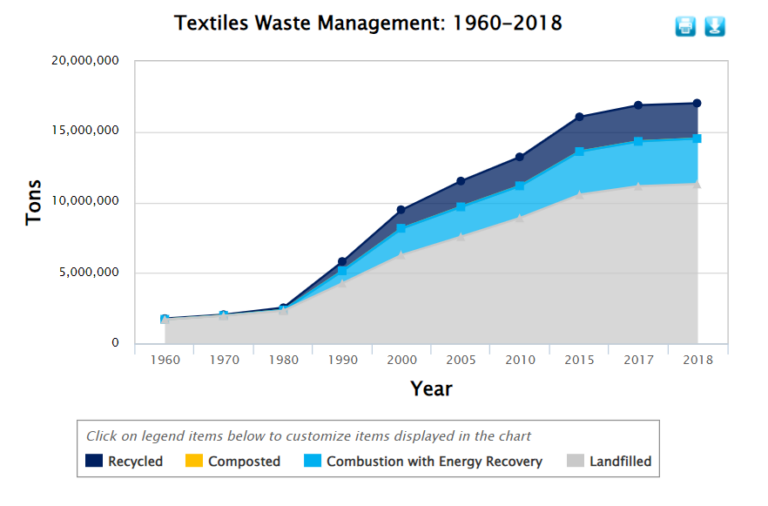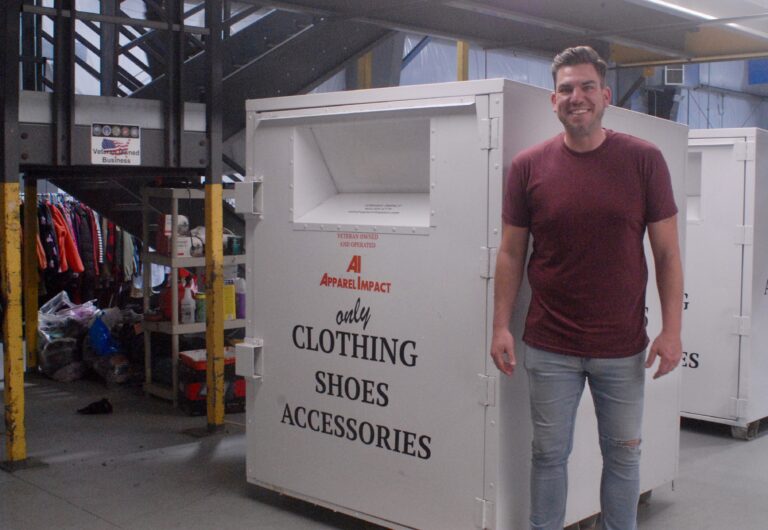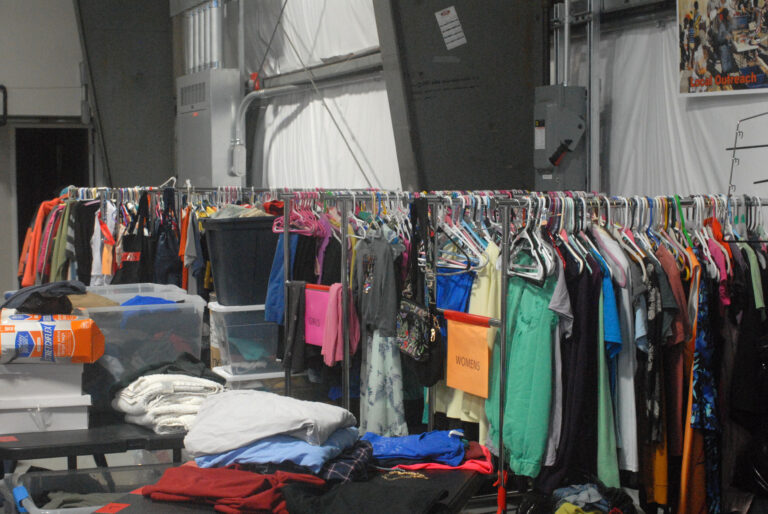 Apparel Impact, a veteran-owned textile recycling company based in Hooksett, diverts used and unwanted clothing, shoes, bedding, and more from landfills to ultimately be repurposed and reused across the country. (Hadley Barndollar | New Hampshire Bulletin)
Apparel Impact, a veteran-owned textile recycling company based in Hooksett, diverts used and unwanted clothing, shoes, bedding, and more from landfills to ultimately be repurposed and reused across the country. (Hadley Barndollar | New Hampshire Bulletin)
Inside a Hooksett warehouse on a humid Tuesday, Joe Whitten explains that it can take up to three generations for a non-biodegradable T-shirt to decompose in a landfill.
That means any clothing made of polyester, rayon, spandex, or nylon.
Last year, Apparel Impact, Whitten’s for-profit company, diverted 10 million pounds of textiles from landfills in New Hampshire, Maine, Massachusetts, Vermont, and New York. At its Hooksett headquarters, bloated capsacks stuffed with 400 pounds of donated clothing, shoes, accessories, and bedding are stacked high, nearing the ceiling.
 A chart from the EPA shows the increase in the amount of textile waste entering landfills from 1960 to 2018. (Screenshot)
A chart from the EPA shows the increase in the amount of textile waste entering landfills from 1960 to 2018. (Screenshot)
Textiles are one of the fastest growing waste streams in the country, approaching 10 percent of total municipal solid waste. The Environmental Protection Agency estimates that landfills nationally received 11.3 million tons of textile waste in 2018, and 3.2 million tons of textiles were incinerated.
“And it’s only getting worse because of fast fashion,” said Whitten, Apparel Impact’s founder and CEO, referring to cheap, trendy clothing that’s mass-produced at low cost.
An endeavor that Whitten began in New Hampshire in 2014, textile reuse and recycling options are a growing need in the U.S. Last year, for example, Massachusetts banned textiles in the trash, meaning residents and businesses now have to seek alternative destinations for their ripped jeans, stained sweaters, or the belt that doesn’t fit anymore. The Bay State also banned mattresses.
As of now, New Hampshire hasn’t pursued waste bans like that of its neighbor to the south, but lawmakers did pass a new law this year to require that entities generating more than one ton of food waste per week find an alternative facility, such as composting or anaerobic digestion, if one is located within 20 miles. But the possibility of other bans is being considered, mainly in conversations among the state’s Solid Waste Working Group, a statutory committee formed in 2021.
The state is also on its way to finding out what exactly is taking up the most room in its landfills. Reagan Bissonnette, executive director of the Northeast Resource Recovery Association, said New Hampshire doesn’t have any concrete data on how much textile waste is being landfilled or incinerated. But the Department of Environmental Services will soon embark on a waste characterization study – a breakdown of what’s being thrown away.
With the mission to divert textiles from landfills and see them go back out into communities either for reuse or in a recycled form, Whitten’s company recently placed its 1,000th donation box across its service area of five states – all of which are visited by drivers weekly, sometimes multiple times.
 Joe Whitten is the CEO and founder of Apparel Impact, which just placed its 1,000th clothing, shoes, and accessories donation bin across six Northeast states. (Hadley Barndollar | New Hampshire Bulletin)
Joe Whitten is the CEO and founder of Apparel Impact, which just placed its 1,000th clothing, shoes, and accessories donation bin across six Northeast states. (Hadley Barndollar | New Hampshire Bulletin)
How Apparel Impact diverts potential textile waste
In 2014, Whitten was an Army veteran who’d decided to leave a computer software company and pursue something related to bettering the environment. He started Apparel Impact by going door-to-door providing donation bags.
“Within the first weekend, I think I picked up 400 bags of clothes,” he said. “So I knew pretty fast, ‘OK, this is a big need,’ and everything I was reading was that textile waste was the fastest growing waste in the country.”
Apparel Impact’s first official donation bins were hand-built out of wood and placed around Manchester, where the company was based up until last year, when it moved to an 18,000-square-foot warehouse in Hooksett.
The company partners with businesses, schools, municipalities, and nonprofits to place its bins in locations that are publicly accessible in well-trafficked areas.
That’s critical, said Whitten. Even he is guilty of driving around for months with clothes he intends to donate stashed in his trunk. If people see donation bins on their way to work or while dropping their child off at school, they’re more likely to use them.
Textile donations placed in the bins are picked up by Apparel Impact drivers and transported to either the Hooksett warehouse or the company’s other facility in New York. Employees then pack capsacks with the donations and weigh them, readying them to be shipped off around the country.
Textiles are treated as a commodity, Whitten explained, and Apparel Impact’s clients are “clothing graders” – large facilities in Maryland, Texas, New Jersey, and New York that go through the capsacks and sort each item, grading them from A to C. Eighty-five percent of what Apparel Impact collects is good enough to be reused or re-worn, while 15 to 20 percent can be recycled for other purposes, such as insulation, padding that goes under flooring and car carpets, and wiping rags.
Clothing graders pay Apparel Impact for their textiles, and from there, the good quality items are sold to thrift, vintage, and consignment stores, and a variety of retail clients across the country.
“One of the missions of Apparel Impact is, ‘How do we change the way people think about clothing?’” Whitten said. “Because for so long it was always about, ‘I want to make sure this bag gets to a local church and a nice lady gets a shirt she needs for cheap or free,’ which is good, but we need a better solution than just to make sure it goes to a local Goodwill or a church.”
There are other players in the New Hampshire textile recycling industry, both for-profit and nonprofit operations. The Manchester Department of Public Works, for example, has contracted with Helpsy, a for-profit recycling company, where residents can request free home pickup of textile donations to ultimately be transported to a Massachusetts facility. Hampton, Exeter, Pembroke, Hooksett, and Bow have also used Helpsy.
The Northeast Resource Recovery Association maintains a list of textile recycling companies that work in New Hampshire.
What sets Apparel Impact apart, Whitten contends, is the direct outreach done by the company and its employees. Inspired by his father, who has been a missionary for 40 years and traveled all over the world, Apparel Impact clothes about 4,000 people locally per year through its own monthly outreach work, Whitten said. The company often partners with Easterseals or low-income school districts to hold distribution events, for example.
‘Fast fashion is an important piece of this’
Both Whitten and the Northeast Resource Recovery Association’s Bissonnette pointed to “fast fashion” as a leading contributor to textile waste.
Whitten recalled his L.L. Bean sweatshirts lasting him through years of schooling. A shirt purchased at many stores today, he said, might last “three washes.”

In addition to repurposing clothing, shoes, and other textiles around the country, Apparel Impact also does its own local outreach to people in need. (Hadley Barndollar | New Hampshire Bulletin)
The global fast fashion market was valued in 2022 at $106 billion. According to a 2017 report by the Ellen MacArthur Foundation, it’s estimated that more than half of fast fashion produced is disposed of in under a year. The industry is often viewed as a significant contributor to the climate crisis, and the EPA says it’s so resource-intensive that it rivals the aviation industry in terms of global carbon emissions.
“Fast fashion is an important piece of this,” Bissonnette said. “We see fashions and trends changing so quickly, and it generates a huge amount of clothing that ultimately is taking up a fair amount of landfill space.”
Bissonnette said NRRA regularly hears from member municipalities about textile recycling. While more populated areas may have a Goodwill or Salvation Army close by, many rural communities rely on donation boxes at the town hall or transfer station to make a dent in their solid waste costs.
“We see that those boxes are very popular,” said Bissonnette. Even if clothing is ripped or stained, she added, or if one shoe is missing from a pair, it can still be recycled.
She expects the state’s Solid Waste Working Group, of which she is a member, will start further discussing textile waste. As of now, the spotlight has been largely on how the state can lessen food waste, which is the single largest contributor to municipal solid waste in New Hampshire.
This story is courtesy of NH Bulletin under creative commons license. No changes have been made to the article.

 Current Issue - April 2024
Current Issue - April 2024